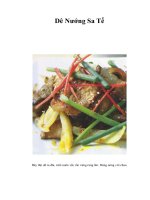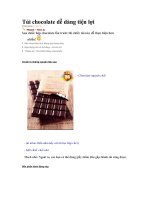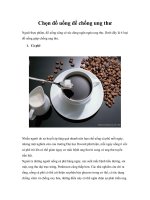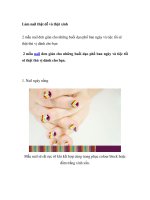Catálogo Instructivo de las Colecciones Mineralógicas doc
Bạn đang xem bản rút gọn của tài liệu. Xem và tải ngay bản đầy đủ của tài liệu tại đây (228.85 KB, 30 trang )
Catálogo Instructivo de las Colecciones
Mineralógicas
ESCOLARES
E. HERMITTÉ - Jefe de la División
G. Bodenbender - Jefe de la Sección Geología
BUENOS AIRES
Talleres de publicationes de la Oficina
Meteorológica
1905
I. CARACTERES MORFOLÓGICOS
CRISTALES (sueltos ó en agregados).
Cubo de Pirita de hierro N
o
5
a
N
o
5
a*
Deltoedro del Analcima » 92
Dodecaedro rómbico, Deltoedro ó combinación de los dos
(Granate)
» 72
» 34* y
34
a*
Pirámide hexagonal del Cuarzo
»
26
a
Pirámide hexagonal con prisma del Cuarzo » 26 » 16*
Romboedro del Espato calizo » 43
» 23* y
24*
Escalenoedro del Espato calizo » 44
Cristales rómbicos (prisma con pinacoide) de la Baritina » 64
Prisma monoclínico con hemipirámide (incompleta) del
Yeso
» 59
Prisma monoclínico del Feldespato » 90
NOTA Los números con estrella se refleren á la colección escolar primaria, los otros
á la colección escolar secundaria.
AGREGADOS 1) Cristalizados.
Cuarzo
» 26 y
27
Espato de cal » 43 » 44
Granate » 72
Baritina » 64
Epídota » 77
Analcima, etc » 92
2) Cristalinos (macro y micro)
Azufre » 1 N
o
1*
Galena » 7 » 6*
Blenda » 11 » 7*
Hematita
» 20 y
21
» 11* y
12*
Estalactitas » 47 » 25*
Mármol » 57 » 43*
Yeso » 60 » 62
»
29*
»
30*
Feldespato, etc. » 91 » 35*
3) Criptocristalinos.
Limonita » 39 » 15*
4) Amorfos (Ópalo, Obsidiana,
etc.)
TEXTURA DE DE LOS AGREGADOS. (Forma interior)
1) Agregados granulosos. (Grano grueso, medio grueso y fino, con
transiciones al fibroso y laminar).
Hierro magnético
»
35
»
19*
Mármol
»
50
»
43*
Sal común
»
40
»
20*
Yeso, etc
»
62
»
30*
2) Agregados fibrosos (Gruesos, medio gruesos,finos, paralelos,
radiados, reticulados, etcétera).
Yeso
»
60
»
29*
Boronatrocalcita
»
42
»
22*
Asbesto
»
84
»
36*
3) Agregados laminares hojosos, micáceos.
Yeso
»
61
Mica
»
74
»
33*
Hematita, etc.
»
21
4) Agregados homogéncos.
Onix-Mármol
»
19
»
26*
NOTA Los agregados compactos están en contraposición á los porosos.
FORMAS EXTERIORES DE LOS AGREGADOS.
1) Estalactitas » 47
2) Alambres y chapas:
Oro, Plata, Cobre
» 2,
3, 4
» 2*,
3*, y 4*
3) Concreciones:
Tosca » 51 » 44*
Boronatrocalcita » 42 » 22*
4) Drusas. (Secreciones):
Espato de cal » 43
Analcima » 92
5) Costras, revestimientos, pegaduras:
Azurita » 58 » 28*
Descloizita » 71
6) Eflorescencias:
Alumbre » 65
Sulfato de magnesio » 66
7) Embutidas:
Granate en feldespato, etc. » 73
Hierro cromífero en Serpentina » 36
8) Vetas ó filones. (Agregados de orden superior) Galena,
blenda, etc., con cuarzo ó espato de hierro, etc.
» 19
FÓSILES (Formas orgánicas)
Plantas fósiles (carbonizadas) » 100 » 50*
Madera fósil silicificada » 34 » 18*
Animales fósiles » 99 » 49*
SEUDOMORFISMO. (Epigenias):
Hierro pardo en cubos, por descomposición de pirita de hierro » 6
MACLAS. (Gemelos), múltiples, caracterizados por estriamiento
sobre los planos de clivaje.
Espato de cal » 45
II. CARACTERES FÍSICOS
CLIVAJE, (ó cruceros):
A) Según la posición de los planos de clivaje:
1) Octaédrico:
Hierro magnético » 35
2) Cúbico:
Galena » 7 » 6*
3) Romboédrico:
Espato de cal » 45 y 46 » 23* y 24*
4) Prismático:
Antimonita » 12
Enargita » 17
B) Según el grado de perfección:
1) Sumamente perfecto:
Mica » 74 » 33*
2) Muy perfecto:
Galena » 7 y 8 » 6*
Espato de cal » 45 y 46 » 23* y 24*
3) Imperfecto ó muy imperfecto.
Cuarzo » 26 y 27 » 16*
Granate » 72
FRACTURA A) Según la forde la superficie:
1) Concoidal: (factura del vidrio grueso) (Obsidiana).
2) Desigual:
Pirita de hierro » 5
Cuarzo » 86 » 17*
3) Llana.
Piedra Córnea.
B) Según la calidad de de la superficie: Lisa:
Piedra córnea y Calcedonia.
2) Astillosa:
Triplita » 70
3) Erizada:
Oro, Plata, Cobre » 2, 3, 4 » 2*, 3* y 4*
4) Terrosa:
Hematita ocrácea » 22 » 11*
Kaolina » 94 » 37*
[pg 008]
DUREZA Escala de dureza:
1) Talco » 80
2) Yeso » 62 » 30*
3) Espato de cal » 45 » 23*
4) Espato fluor » 41 » 21*
5) Apatita » 69
6) Ortoclasa » 91 » 35*
7) Cuarzo » 28 » 16*
8) Topacio.
9) Corindón.
10) Diamante.
1) Minerales muy blandos, rayados por la uña (grados 1
hasta 3)
Oro, Plata, Cobre
» 2, 3,
4
» 2*, 3* y
4*
Galena » 7 » 6*
Sal común » 40 » 20*
Yeso
» 60 y
63
» 29* y
30*
Mica » 74 » 33*
Kaolina » 94 » 37*
2) Minerales que no son rayados por la uña, pero si por la
punta de un cuchillo (grados 3 hasta 5).
Blenda » 10 » 7*
Calcita » 43 » 22*
Espato fluor » 41 » 21*
3) Minerales que no son rayados por la punta de un
cuchillo (grados 6 en adelante).
Feldespato. N
o
91 N
o
35*
Cuarzo » 28
» 16* y
17*
Granate etc. » 72 » 34*
TENACIDAD 1) frágiles:
Pirita de hierro » 5 » 5*
Cuarzo » 26 etc. » 17*
Caliza etc. » 43 » » 22* y 23*
2) Sectiles: Chalcosina » 9
Talco » 81
3) Maleables (ductil): Oro, Plata, Cobre » 2, 3, 4 » 2, 3, 4*
4) Elásticos: Mica » 74 » 33*
5) Flexibles (Clorita, Talco, Asbesto).
LUSTRE a) Según cantidad. Mui lustroso:
Mica » 74 » 33*
Espato de Islandía » 45 » 23*
Lustroso:
Galena » 7 » 6*
Granate » 72 » 34*
Poco lustroso:
Feldespato » 91 » 35*
Berilo » 88
Mate:
Caolina » 94 » 37*
b) Según calidad: Metálico:
Oro, Plata, Cobre
» 2, 3, y
4
» 2*, 3* y
4*
Pirita de hierro etc. » 5 » 5*
Diamantino: (Diamente) Vidrioso:
Espato de cal » 45 » 23*
Cuarzo (sobre las caras de los cristales » 26 » 16*
Grasoso: (ó resinoso): Cuarzo sobre los planos de de
fractura)
» 26 y
27
» 16 y 17*
Wolframita (sobre los planos de fractura » 67 » 31*
Perlado: (nacarado).
Mica » 74 » 33*
Crisotila » 83 » 36*
Sedoso:
Wolastonita » 85
Aragonita » 52
Alumbre » 65
Boronatrocalcita » 22 » 22*
DIAFANIDAD:
Transparente:
Espato de Islandia » 45 » 23*
Semi-transparente:
Cuarzo » 26 » 16*
Translúcido:
Onyx » 49 » 26*
Semi translúcido:
Feldespato » 90 » 35*
Opacos:
Oro, Plata, Pirita de hierro, etc.
COLOR: Minerales incoloros (en su estado puro)
Cuarzo
»
26
»
16*
Sal común
»
40
»
20*
Espato de Islandia
»
45
»
23*
2) Minerales con colores propios (idiocromáticos) Oro, Plata,
Cobre.
Pirita de hierro » 5 » 5*
Malaquita
»
56
»
28*
3) Minerales con colores accidentales (alocromáticos)
Cuarzo rosado
»
29
»
17*
Onyx Mármol » »
49 26*
Espato-Fluor
»
41
»
21*
Granate
»
72
»
34*
Feldespato
»
91
»
35*
COLORES METÁLICOS: Blancos:
Blanco de plata » 3 » 4*
(Blanco de estaño) Amarillos:
De oro » 2 » 2*
De bronce » 5 » 5*
De latón » 13 » 9*
Gris:
De plomo » 7 » 6*
Rojo:
De cobre » 4 » 3*
Negro:
De acero hasta negro de hierro
Enargita » 17 » 10*
Hematita » 20 » 12*
Pirolusita » 24 » 13*
COLORES NO METÁLICOS: Blancos (tipo blanco de
nieve):
Yeso Nº 60
Nº 29* y
30*
Caliza
» 46 y
47
» 24* y 25*
Wolastonita » 85
Grises (tipo gris de ceniza):
Tierra de infusorios » 33
Negros (tipo negro de terciopelo):
Turmalina » 76 » 32*
Carbón de piedra » 97 » 38*
Azules (tipo azul de Prusia):
Azurita » 58 » 28*
Verdes (tipo verde de esmeralda):
Malaquita » 56 » 28*
Onix-mármol » 49 » 26*
Crisocola » 79
Apatita » 69
Epídota
» 77 y
78
Serpentina » 82
Amarillos (tipo amarillo de limón).
Azufre » 1 » 1*
Ocre de hierro » 39 » 15*
Rojos (tipo rojo-carmesí):
Hematita ocrácea » 22 » 11*
Cuarzo rosado » 29 » 17*
Pardos (tipo pardo de castaño):
Limonita » 37 » 14*
Triplita » 70
RAYA (color del polvo del mineral):
1) Minerales incoloros (al estado puro) ó alocromáticos. Tienen por
lo común un polvo blanco ó gris:
Cuarzo rosado
»
29
»
17*
Espato fluor » 4
»
21*
Turmalina
»
76
»
32*
Feldespato
»
91
»
35*
2) Minerales con colores propios (idiocromáticos). El color del
mineral y de su polvo no difieren ó son por lo menos parecidos:
Galena (polvo gris-oscuro) » 7 » 6*
Hematita (polvo rojo-parduzco)
»
20
»
11*
Malaquita (polvo verde)
»
56
»
28*
3) Minerales maleables. Se ponen lustrosos por frotamiento:
Oro, plata, cobre.
COLORES MULTIPLES (por agregación):
Espato fluor » 41 » 21*
COLORES SUPERFICIALES (abigarrados, en mayor parte debido á
una descomposición química):
Pirita de cobre
» 13,
14
»
9*
IRISACIÓN:
Espato de Islandia.
FOSFORESCENCIA:
Cuarzo, Espato fluor, etc.
DOBLE REFRACCIÓN:
Espato de Islandia. etc.
ELECTRICIDAD:
Azufre, Cuarzo, Espato calizo, Mica, Turmalina.
[pg 014]
MAGNETISMO: Hierro magnético 35 » 19*
PESO ESPECÍFICO: (Densidad)
0,6 1 Kerosene, Agua
1 1,5 Hulla.
1,5 2,0 Alumbre.
2,0 2,5 Yeso, Sal común.
2,5 3,0 Cuarzo, Calcita, Feldespato.
3,0 3,5 Espato Fluor, Turmalina.
3,5 4,0 Malaquita, Azurita.
4,0 4,5 Pirita de cobre, Blenda.
4,5 5,5 Pirita de hierro, Cobre gris.
5,5 6,5 Magnetita, Chalcosina.
6,5 8 Cerusita, Casiterita, Galena.
8,5 10,0 Cobre, Bismuto.
10,0 14,0 Plata, Plomo, Mercurio.
15,0 21 Oro, platino.
21,5 23 Iridio.
[pg 015]
III. CARACTERES FISIOLÓGICOS
1) Por frotamiento emite olor á azufre:
Pirita de hierro » 5 » 5*
2) Cuando se le echa el aliento emite olor terroso:
Kaolina y tierras » 94 » 37*
3) Se pega á la lengua:
Kaolina y tierras » 94 » 37*
4) Untuoso al tacto;
Talco » 81
5) Sabor salino:
Sal común » 40 » 20*
6) Sabor salino amargo:
Sulfato de magnesio » 66
7) Sabor metálico:
Vitriolo de cobre.
IV. CARACTERES QUÍMICOS
1
FUSIBILIDAD 1) Minerales facilmente fusibles (fusibles con la llama de una
vela:
Antimonita, Sal común.
2) Dificilmente fusibles á un globulito:
Granate (Almandina).
3) Facilmente fusibles en astillas finas:
Feldespato.
4) Dificilmente fusibles en astillas: Bronzita.
5) Infusibles á la llama del soplete: Cuarzo.
Según Kobell, hay siete grades de fusibilidad.
1) Antimonita.
2) Natrolita.
3) Almandina.
4) Actinolita.
5) Ortoclasa.
6) Bronzita.
7) Cuarzo.
SUBLIMACIÓN: (total ó parcial).
Azufre, Pirita de hierro,
SOLUBILIDAD: A) En agua: Sal común.
B) En ácido clorhídrico:
1) Con desprendimiento de ácido carbónico: Caliza.
2) Con desprendimiento de cloro: Pirolusita.
3) Con desprendimiento de ácido sulfhidrico: Blenda.
C) En ácido nitrico, con desprendimiento de bióxido de nitrógeno (vapores
rutilantes): Hierro magnético.
D) Parcialmente solubles en los ácidos:
1) Sulfuros, solubles en ácido nitrico concentrado, con separacion de
azufre:Blenda, Pirita de hierro.
2) Silicatos solubles en ácido clorhídrico con separación de ácido sílicico.
a) Bajo la forma de polvo arenoso: Serpentina.
b) Bajo la forma de masa gelatinosa: Wolastonita.
3) Wolframatos solubles (en polvo muy fino) en ácido clorhídrico
concentrado, separándose ácido wolfrámico: Wolframita.
E) Insolubles en los ácidos Cuarzo, Espato fluor, Feldespato.
DISGREGACÍON DE MINERALES INSOLUBLES EN LOS ÁCIDOS por fusión con carbonatos
alcalinos: Cuarzo, Feldespato.
INVESTIGACIÓN DE LOS COMPONENTES MÁS IMPORTANTES.
Agua. Agua higroscópica: Sal común.
Agua de cristalización: Yeso.
Agua de cristalización y de constitución: Serpentina.
Acido sulfhídrico ó azufre: Galena, Blenda.
Acido clorhídrico: Sal común.
Ácido fluorhídrico: Espato fluor.
Acido sulfúrico: Yeso.
Acido fosórico: Apatita.
Acido carbónico: Espato de cal, Cerusita.
Acido sílicico: Serpentina, Feldespato, Wolastonita.
Cobre: Pirita de cobre. Crisocola.
Zinc: Blenda.
Plomo: Galena. Cerusita.
Hierro: Pirita de hierro. Hierro magnético.
Antimonio: Antimonita. Enargita.
Arsénico: Hierro arsenical.
Manganeso: Pirolusita. Wolframita.
Aluminio: Alumbre. Ortoclasa.
Calcio: Espato de cal. Yeso.
Magnesio: Sulfato de magnesio.
Sodio: Sal común.
Potasio: Feldespato.
[pg 019]
COLECCIÓN DE MUESTRAS DE ENSAYO
N.º 1 Blenda.
» 2 Galena.
» 3 Pirita de hierro.
» 4 Limonita ó Hematita.
» 5 Cuarzo.
» 6 Pirolusita.
» 7 Espato fluor.
» 8 Sal común.
» 9 Espato calizo.
» 10 Cerusita.
» 11 Yeso.
» 12 Sulfato de magnesia.
» 13 Apatita.
» 14 Wolframita.
» 15 Serpentina.
» 16 Wolastonita.
» 17 Crisocola.
» 18 Feldespato.
ALGUNOS EJEMPLOS DE LA FORMACIÓN DE MINERALES
A) Minerales formados en disoluciones acuosas por
evaporación del agua:
Sal común
Nº
40
Yeso » 59
Calcedonia » 31
Cuarzo cristalizado » 27
B) Minerales formados en disoluciones acuosas
cargadas de ácido carbónico, por evaporación de este
último.
Espato calizo
Nº
44,
etc.
(dentro de
grietas que
cruzan el
mármol.
Estalactitas » 47
(dentro de
cavernas en
caliza).
Travertina » 48
(en agua bajo la
acción de
plantas).
Onyx-Mármol » 49
(en aguas
calientes)
C) Minerales formados por procesos químicos; par la
acción del oxígeno, del ácido carbónico y del agua:
1) Limonita, por descomposición de Pirita de hierro
Nº
38
3) Cerusita, por descomposición de Galena » 53
4) Malaquita por descomposición de Cobre » 4
5) Analcima, por descomposición de Basalto » 92
6) Caolina, por descomposición de Feldespato » 94
D) Minerales formados en una masa fusión (rocas
eruptivas)
Feldespato en granito » 91
Cuarzo » 28
Mica en granito » 74
Anfibol » 86
E) Minerales en filones metálicos, como: Galena, Pirita
de hierro, Blenda, etc., formados:
1) por procedimientos de disoluciones acuosas, ej.:
sulfato de hierro, ha sido reducido á sulfuro de hierro, ó
2) por acción del gas sulfhídrico (ó sulfuros alcalinos)
sobre disoluciones; ej.: carbonato de plomo,
transformado en galena:
3) por sublimación de gases (casos raros)
4) por reducción de sus disoluciones ó de minerales
compuestos: oro nativo por reducción de cloruro de oro;
cobre nativo en parte por reducción de óxido de cobre
(cobre rojo) ó de malaquita (carbonato de cobre)
***END OF THE PROJECT GUTENBERG EBOOK CATÁLOGO INSTRUCTIVO
DE LAS COLECCIONES MINERALÓGICAS***
Credits
December 22, 2006
Project Gutenberg Edition
Adrian Mastronardi
Joshua Hutchinson
Online Distributed Proofreading Team
This file was produced from images generously made available by the
Bibliothèque nationale de France (BnF/Gallica) at
A Word from Project Gutenberg
This file should be named 20159-h.html or 20159-h.zip.
This and all associated files of various formats will be found
in:
Updated editions will replace the previous one — the old editions will be renamed.
Creating the works from public domain print editions means that no one owns a
United States copyright in these works, so the Foundation (and you!) can copy and
distribute it in the United States without permission and without paying copyright
royalties. Special rules, set forth in the General Terms of Use part of this license,
apply to copying and distributing Project Gutenberg™ electronic works to protect the
Project Gutenberg™ concept and trademark. Project Gutenberg is a registered
trademark, and may not be used if you charge for the eBooks, unless you receive
specific permission. If you do not charge anything for copies of this eBook,
complying with the rules is very easy. You may use this eBook for nearly any purpose
such as creation of derivative works, reports, performances and research. They may be
modified and printed and given away — you may do practically anything with public
domain eBooks. Redistribution is subject to the trademark license, especially
commercial redistribution.
The Full Project Gutenberg License
Please read this before you distribute or use this work.
To protect the Project Gutenberg™ mission of promoting the free distribution of
electronic works, by using or distributing this work (or any other work associated in
any way with the phrase Project Gutenberg), you agree to comply with all the terms of
the Full Project Gutenberg™ License (available with this file or online
at
Section 1.
General Terms of Use & Redistributing Project Gutenberg™ electronic works
1.A.
By reading or using any part of this Project Gutenberg™ electronic work, you indicate
that you have read, understand, agree to and accept all the terms of this license and
intellectual property (trademark/copyright) agreement. If you do not agree to abide by
all the terms of this agreement, you must cease using and return or destroy all copies
of Project Gutenberg™ electronic works in your possession. If you paid a fee for
obtaining a copy of or access to a Project Gutenberg™ electronic work and you do not
agree to be bound by the terms of this agreement, you may obtain a refund from the
person or entity to whom you paid the fee as set forth in paragraph 1.E.8.
1.B.
Project Gutenberg is a registered trademark. It may only be used on or associated in
any way with an electronic work by people who agree to be bound by the terms of this
agreement. There are a few things that you can do with most Project Gutenberg™
electronic works even without complying with the full terms of this agreement. See
paragraph 1.C below. There are a lot of things you can do with Project Gutenberg™
electronic works if you follow the terms of this agreement and help preserve free
future access to Project Gutenberg™ electronic works. See paragraph 1.E below.
1.C.
The Project Gutenberg Literary Archive Foundation (the Foundation or PGLAF),
owns a compilation copyright in the collection of Project Gutenberg™ electronic
works. Nearly all the individual works in the collection are in the public domain in the
United States. If an individual work is in the public domain in the United States and
you are located in the United States, we do not claim a right to prevent you from
copying, distributing, performing, displaying or creating derivative works based on
the work as long as all references to Project Gutenberg are removed. Of course, we
hope that you will support the Project Gutenberg™ mission of promoting free access
to electronic works by freely sharing Project Gutenberg™ works in compliance with
the terms of this agreement for keeping the Project Gutenberg™ name associated with
the work. You can easily comply with the terms of this agreement by keeping this
work in the same format with its attached full Project Gutenberg™ License when you
share it without charge with others.
1.D.
The copyright laws of the place where you are located also govern what you can do
with this work. Copyright laws in most countries are in a constant state of change. If
you are outside the United States, check the laws of your country in addition to the
terms of this agreement before downloading, copying, displaying, performing,
distributing or creating derivative works based on this work or any other Project
Gutenberg™ work. The Foundation makes no representations concerning the
copyright status of any work in any country outside the United States.
1.E.
Unless you have removed all references to Project Gutenberg:
1.E.1.
The following sentence, with active links to, or other immediate access to, the full
Project Gutenberg™ License must appear prominently whenever any copy of a
Project Gutenberg™ work (any work on which the phrase Project Gutenberg appears,
or with which the phraseProject Gutenberg is associated) is accessed, displayed,
performed, viewed, copied or distributed:
This eBook is for the use of anyone anywhere at no cost and with almost no
restrictions whatsoever. You may copy it, give it away or re-use it under the terms of
the Project Gutenberg License included with this eBook or online
at
1.E.2.
If an individual Project Gutenberg™ electronic work is derived from the public
domain (does not contain a notice indicating that it is posted with permission of the
copyright holder), the work can be copied and distributed to anyone in the United
States without paying any fees or charges. If you are redistributing or providing access
to a work with the phrase Project Gutenberg associated with or appearing on the work,
you must comply either with the requirements of paragraphs 1.E.1 through 1.E.7 or
obtain permission for the use of the work and the Project Gutenberg™ trademark as
set forth in paragraphs 1.E.8 or 1.E.9.
1.E.3.
If an individual Project Gutenberg™ electronic work is posted with the permission of
the copyright holder, your use and distribution must comply with both
paragraphs 1.E.1 through 1.E.7 and any additional terms imposed by the copyright
holder. Additional terms will be linked to the Project Gutenberg™ License for all
works posted with the permission of the copyright holder found at the beginning of
this work.
1.E.4.
Do not unlink or detach or remove the full Project Gutenberg™ License terms from
this work, or any files containing a part of this work or any other work associated with
Project Gutenberg™.
1.E.5.
Do not copy, display, perform, distribute or redistribute this electronic work, or any
part of this electronic work, without prominently displaying the sentence set forth in
paragraph 1.E.1with active links or immediate access to the full terms of the Project
Gutenberg™ License.
1.E.6.
You may convert to and distribute this work in any binary, compressed, marked up,
nonproprietary or proprietary form, including any word processing or hypertext form.
However, if you provide access to or distribute copies of a Project Gutenberg™ work
in a format other than Plain Vanilla ASCII or other format used in the official version
posted on the official Project Gutenberg™ web site (), you
must, at no additional cost, fee or expense to the user, provide a copy, a means of
exporting a copy, or a means of obtaining a copy upon request, of the work in its
original Plain Vanilla ASCII or other form. Any alternate format must include the full
Project Gutenberg™ License as specified in paragraph 1.E.1.
1.E.7.
Do not charge a fee for access to, viewing, displaying, performing, copying or
distributing any Project Gutenberg™ works unless you comply with
paragraph 1.E.8 or 1.E.9.
1.E.8.
You may charge a reasonable fee for copies of or providing access to or distributing
Project Gutenberg™ electronic works provided that
•
You pay a royalty fee of 20% of the gross profits you derive from the use of Project Gutenberg™ works
calculated using the method you already use to calculate your applicable taxes. The fee is owed to the owner
of the Pro
ject Gutenberg™ trademark, but he has agreed to donate royalties under this paragraph to the
Project Gutenberg Literary Archive Foundation. Royalty payments must be paid within 60 days following
each date on which you prepare (or are legally required to pr
epare) your periodic tax returns. Royalty
payments should be clearly marked as such and sent to the Project Gutenberg Literary Archive Foundation at
the address specified inSection 4,
Information about donations to the Project Gutenberg Literary Archive
Foundation.
You provide a full refund of any money paid by a user who notifies you in writing (or by e
-
days of receipt th
at s/he does not agree to the terms of the full Project Gutenberg™ License. You must
require such a user to return or destroy all copies of the works possessed in a physical medium and
discontinue all use of and all access to other copies of Project Gutenberg™ works.
You provide, in accordance with paragraph 1.F.3
, a full refund of any money paid for a work or a
replacement copy, if a
defect in the electronic work is discovered and reported to you within 90 days of
receipt of the work.
You comply with all other terms of this agreement for free distribution of Project Gutenberg™ works.
1.E.9.
If you wish to charge a fee or distribute a Project Gutenberg™ electronic work or
group of works on different terms than are set forth in this agreement, you must obtain
permission in writing from both the Project Gutenberg Literary Archive Foundation
and Michael Hart, the owner of the Project Gutenberg™ trademark. Contact the
Foundation as set forth in Section 3 below.
1.F.
1.F.1.
Project Gutenberg volunteers and employees expend considerable effort to identify,
do copyright research on, transcribe and proofread public domain works in creating
the Project Gutenberg™ collection. Despite these efforts, Project Gutenberg™
electronic works, and the medium on which they may be stored, may
contain Defects, such as, but not limited to, incomplete, inaccurate or corrupt data,
transcription errors, a copyright or other intellectual property infringement, a defective
or damaged disk or other medium, a computer virus, or computer codes that damage
or cannot be read by your equipment.









